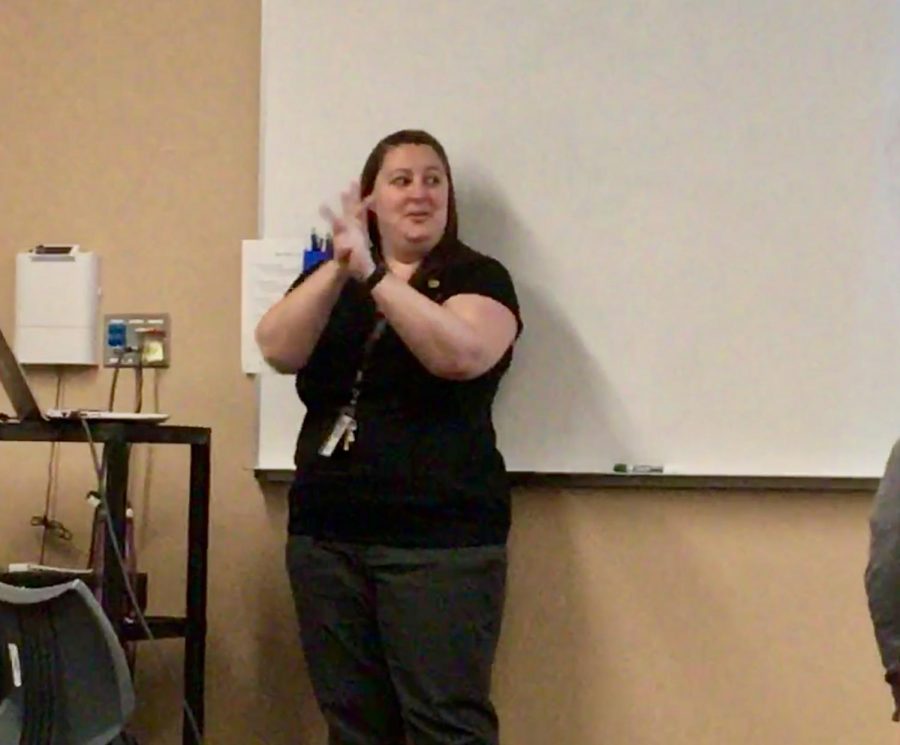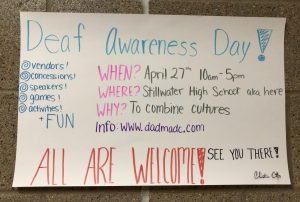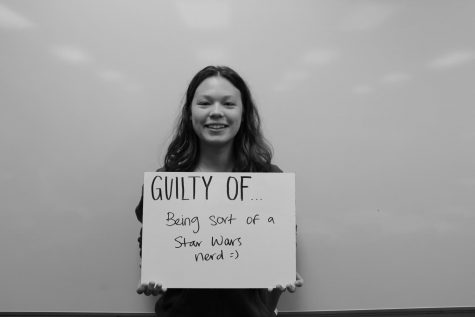New ASL teacher joins World Language Department
ASL teacher Amanda McKinnon reviews previous course content with her ASL 3 class on the morning of Sept. 12. She demonstrates the sign for “borrow”.
October 2, 2019
The walls of the classroom are bare, the cabinet behind the teacher’s desk void of personal photos, art, or mementos. The walls may be empty, but the chairs are not. No more than 20 students sit in rows, facing the front, all without desks. Despite the plain appearance of the classroom and the early hour of the morning, the atmosphere is far from boring in this second hour, American Sign Language class. The students are clearly enjoying themselves as they spend the last couple minutes of the hour playing a review game of Jeopardy! with questions tailored to sign language subjects, terms, and concepts covered in their previous years of ASL. The teacher at the front of the room is enjoying herself too, patiently waiting for teams to produce the sign asked for, and watching, pleased, as the gears in the students’ heads turn, dusting off their signing skills.
Amanda McKinnon is the new ASL teacher, and this is the classroom she has just moved into. This hour is her one ASL 3 class, and the rest of the day she will teach ASL 1 to the many new faces of the World Language Department.
“She seems like she’s eager to be successful,” fellow ASL teacher Amy Caslow said. “And I think the students are liking her and things seem to be going smoothly. I, you know, I’m not up there every day, but I try my best to support her in every way I can.”
Caslow teaches ASL 2, but, like McKinnon, she also teaches ASL 3. ASL 3 classes go more in-depth than the previous courses, and the students are ultimately striving to be able to express themselves fluently in sign. The classes are mostly all in sign language.
“I would say a lot of it is not so much about vocabulary and knowing every word, it’s a lot about context and kind of using your facial expressions and understanding other people’s facial expressions,” ASL 3 student, senior Kyra O’Loughlin explained. “It’s not really a language where you can translate every single sign to an English word. There’s a lot of, you know, acting it out, classifiers, and facial expressions.”
ASL is a visual, expressive language, completely separate from English. Besides achieving fluency, the ultimate goal of the ASL course is to be able to use the language with Deaf people in the Deaf community.
“Something I really like for an ASL teacher to do is to really focus on teaching more, like, things we can use in the real world,” O’Loughlin said. So far, the teachers have been doing that. In ASL 2, the students were more frequently assigned and encouraged to sign at Deaf events and interact with native signers, O’Loughlin explained.
This sought after “real-life” experience is something that ASL teacher Amanda McKinnon hopes she can bring to the classroom. She worked as a sign language interpreter for 11 years, and has been active within the Deaf community for 30.
“It’s a lot of experience with different language. So I think that brings a really unique perspective to the curriculum,” McKinnon explained. “One sided, it just is: ‘This is the sentence, period.’ And so I have seen that sentence signed by native users in 18 different ways. And so I bring that different perspective to say: ‘Okay, yeah, this is what your book says. And you might see that, but you might also see this, and you might also see this.’”
Caslow also interpreted work before she taught. She agrees with McKinnon on the importance of that experience.
“Just having the community knowledge and the street knowledge, the base of vocabulary and the experience with people, helps when you’re teaching other people in this same community,” Caslow said.
McKinnon started signing when she was young, when her preschool teacher signed along to the alphabet and numbers. Right away, McKinnon was hooked, and began studying the ASL dictionary from her small town library every night with her mom. When she was eight, her family moved from Wisconsin back to Minnesota, and she ended up going to church with a Deaf girl of the same age.
“She and I kind of grew up together,” McKinnon recalled. “I started watching the interpreters at church and started talking with her and just kind of fell in love with it.”
Years later, McKinnon attended St. Paul college for her General Education Credits, and went on to study at St. Catherine’s University for her certification in interpreting. From there she became a freelance interpreter, working “anywhere, everywhere”. This work involved interpreting at weddings, funerals, doctor’s appointments, job interviews and meetings, McKinnon explained. For the last five years, McKinnon has been interpreting in St. Paul Public Schools, and has worked at Humboldt High School.
“They ship the deaf kids from all over the district and even all over the state there to Humboldt so that they can go to school with other hearing kids, but also with a group of deaf kids,” she explained. “Then they had six interpreters in house that go. That’s what I did. And we go from class to class with the kiddos and interpret for their teachers.”
Yet, even with all the valuable cultural experience that interpreting granted McKinnon, it can also be a little tricky to switch professions. The jump from interpreting to teaching ASL is significant, although it is not necessarily always a jump up.
“You’re used to performing at a much higher level than the students are used to,” Caslow explained. “As an interpreter, you are more used to speed. And of course, you’re very accustomed to accuracy. So you kind of have to lower your standards a little bit, and slow down a little bit and be patient as the students grow to that level.”
The switch can be challenging in another way altogether. Teaching keeps students on their toes.
“Teenagers/students are unpredictable,” Caslow said. “And you just have to kind of be ready to be flexible and shift on the fly. So always be ready for any question or any behavior or any surprise working in a school. And always be ready to not have all the answers.”
As the school year begins to kick into full swing, taking McKinnon along for the ride, she remains confident in her decision to become a teacher. Her new cabinets may still be bare, but her hopes certainly are not.
“For me, the moment was the last five years working in the school, and seeing how the kiddos would light up when they would learn something, you know, just that ‘aha’ moment,” she described. “And it was like, that’s partially because of me. I was involved in that. And that feels so cool to see someone change and grow and know that you’re involved in it,” she smiled. “This is where I want to be.











